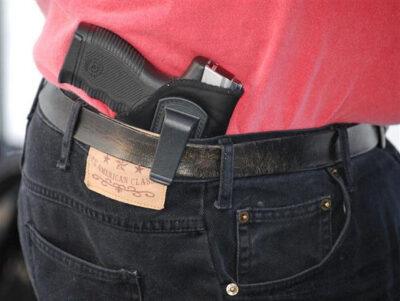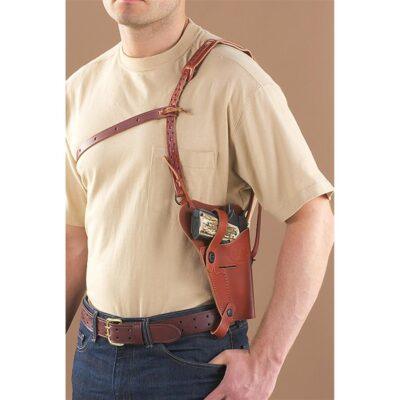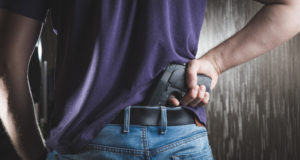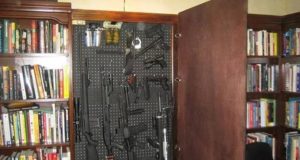There are many different options for carrying your sidearm on your homestead, and each one has its own set of pros and cons.
Let’s look at four:
1. Belt Holster
There are two main options for belt holsters: the quick draw style of holster and the cross draw style of holster. The quick draw style of holster keeps your weapon on your right or left side with the end of the pistol’s grip facing behind you. The cross draw style of holster turns the weapon in reverse, meaning that you have to reach across your side to grab the pistol, or you can twist the wrist of one hand to draw the pistol that way. A cross draw style of holster allows, albeit weakly, for you to draw your handgun with either hand. A quick draw style of holster allows for a faster draw, but only with one hand.
No doubt, belt holsters are the most common way to carry a sidearm, and for good reason. It’s practical, is mostly out of the way, and allows for a fast draw if needed. Depending on the weight and size of the gun, you may even forget that you have the handgun on you after a few hours. A belt holster is a great choice to carry a handgun for homesteading around your property, while on an ATV or motorcycle ride, and even for hunting.
2. Drop Leg Holster
Also known as thigh holsters, drop leg holsters have become more popular as of late. Drop leg holsters are very versatile; the grip of your pistol will be by your hand when hanging your arm loosely by your side, allowing you to keep your hand on the pistol’s grip as often as you want without bending your elbow. Most drop leg holsters also have a thumb strap to keep the weapon secure in the holster. They are also very loose, allowing you to swing the holster to the top of your leg when sitting down or to get it out of the way when doing anything else.
How To Hide Your Guns, And Other Off-Grid Caches…
But the fact that drop leg holsters are loose can also be taken as a con, as they won’t be very practical when walking around or performing chores. You’ll feel the strain of the drop leg holster over time and will repeatedly have to put the holster back into the more comfortable position. If you have to take care of your homestead, the drop leg holster may get in the way and you’ll spend more time than you want dealing with it.
Drop leg holsters are excellent for packing on a mission when fully loaded up (you have easy access to the weapon and it is kept out of the way of your other equipment), but if you are looking for a comfortable way to carry your sidearm while walking around on your property, you’ll want to seek out other options.
3. Shoulder Holster
Shoulder holsters have been popularized in many movies, from James Bond who strapped on his trademark Walther PPK, to Dirty Harry who packed his own Smith & Wesson .44 Magnum in a shoulder holster.
As an open carry option, a shoulder holster is not a bad way to go. Your handgun and two spare magazines (or speed loaders) are on you and kept out of your way. Your hands are free to move, and you don’t have to worry about your gun slipping at your side as you would a belt or drop leg holster. However, shoulder holsters are also quite noticeable in that you won’t forget you’re wearing one as you may a belt holster.
Drawing from a shoulder holster adequately requires a lot of practice and also the use of two hands to be done efficiently; one hand placed on the holster and the other hand for drawing. There are many variations of shoulder holsters, as the holster can be placed at a 45-degree or 90-degree angle, or anywhere in between.
My Personal Defender: Low Cost Way To Defend Yourself Against Lowlife Criminal Scum!
One great advantage to using a shoulder holster is your ability to draw quickly while behind the wheel of a car. Whereas you may fumble to draw from your belt holster while sitting in a vehicle, with a shoulder holster you can simply move your arm across your torso to draw quickly.
4.Tactical Vest Holster/Chest Rig Holster
Most tactical vests and chest rigs out on the market have a holster included in them. They also have enough space and compartments to hold up to five or six rifle magazines, a pouch for shotgun shells, a radio pouch, up to six spare pistol magazines, a compartment for a knife, and even more compartments and Velcro for other accessories.
When you are fully loaded up and on a mission, tactical vests and chest rigs are excellent. They may be heavy, but your equipment, ammunition and weapons are within easy reach and all in front of you. Tactical vests have a cross draw style holster on one side of the torso, while chest rigs have a holster across the chest. Your handgun is kept out of the way and in front of you, and you can hold your rifle by the sling at your side without having the stock knock itself into the grip of your pistol sticking out of a belt or drop leg holster.
But when all is said and done, the tactical vest or a chest rig is what it is: a place for you to store your equipment for easy access while on a mission. Are you really going to walk around your homestead, hunt or perform basic chores fully loaded up and ready to go? Of course not. It’s great that you have full access to all of your weapons and equipment 24/7, but tactical vests and chest rigs are undeniably heavy and are made for what they’re made for. The strain of them will wear down on you over time.
Which type of holster do you prefer? Leave your tips in the section below:
 Off The Grid News Better Ideas For Off The Grid Living
Off The Grid News Better Ideas For Off The Grid Living






